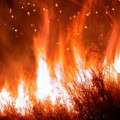2006 has been the worst year on record for wildfires in America. The problem has been especially severe in mountainous, heavily-forested Western states such as Montana, where an estimated 400,000 hectares have burned so far this fire season.
Fire knows no political or bureaucratic boundaries, and the National Interagency Fire Center in Boise, Idaho, is at the core of the federal effort to coordinate the logistics and manage the resources necessary to fight these fires.
The walls are covered with regional maps and up-to-the-minute technical charts in the room where representatives of the National Park Service, the Bureau of Land Management and seven other federal agencies gather every morning around a long conference table to plan the day's work. Among the experts present are National Guard personnel, meteorologists and wildfire analysts, who look at weather patterns and ground data for 13 geographic regions, and try to predict fire behavior.
This cooperative, inter-agency approach to fighting wildfires is relatively new. Fifty years ago, each federal agency had its own firefighting program, and effective communication among agencies was rare. That's no longer true. To demonstrate, Fire Information Officer Russel Rivera proudly conducts a reporter into the National Interagency Coordination Center. It's a large open office space crammed with computers, maps, charts, clocks, planning boards and check-lists, where Fire Center staffers compile the daily situation report for use by all the agencies, as well as by local and regional firefighting departments. "Essentially this is a large dispatch center broken down into four sections," explains Rivera. "We've got a section for Overhead and Crews, for calling out more people; a section for Aviation, for calling out airplanes and tankers; a section for Intelligence and Predictive Services, which is the section that does all the weather across the country and how it might effect the fire season and the next couple days of fire." But how does the Fire Center come up with strategies for fighting specific wildfires, when simply extinguishing a fire with water is not always possible, or even desirable?
Dan Buckley, a veteran fire specialist with the National Park Service, often advocates containing the spread of a wildfire by eliminating the fuel in its path using so-called "controlled burns," or allowing a fire to spread to a place it cannot cross, such as a river, or a plowed field. "So we'll put a box around that fire," says Buckley. "If the weather cools off and the fire behavior slows down, we may chose to go after that fire directly." That means that firefighters will go right into that fire, right to the fire's edge "and build a 'control line' with hand tools, rakes, axes and chainsaws," he says. "Or we could build a machine line using a bulldozer or tractor plow to remove fuel so the fire will stop burning." If the fire is extreme then firefighters might look at conditions far from the fire's edge. "We may be looking for a mountain range with bare rock," says Buckley, or "we may look at a change in fuel type where the fuels are not quite as combustible or available to burn because of their moisture content." Fighting wildfires also "depends heavily on air support," says Jim Turner of the U.S. Forest Service. As liaison officer of the Modular Airborne Fire Fighting System, he coordinates joint missions between the Fire Center and the military Guard units that fly huge Hercules tanker planes, which drop flame retardant ahead of fires to halt the spread of fires in places too remote or dangerous for ground crews to reach.
"Basically the federal agencies are providing a mission, and the military is providing a platform by which to accomplish the mission," says Turner. "It's a very symbiotic relationship that works very well." That relationship is tested every summer season as lightning strikes, careless campers and, sometimes, arsonists routinely set America's wild lands ablaze.

